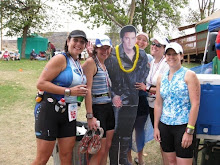I thought this was a GREAT post from Joanna Zieger's blog, Fast at Fourty.....
It was pointed out by my father that many of my posts deal with injury and illness. I explained that the original intention of this blog was to chronicle my story of healing from the crash in November. My purpose was two-fold; writing about the aftermath of a serious incident would serve as an outlet for me as I convalesce and hopefully my ruminations would help others faced with difficulty.
Athletes are not patient people, and we are accustomed to things happening in a time-frame that we dictate. The body does not work in such a manner. Believe me, I have tried to force my body to heal on my timetable, but, alas, I have lost that battle. And, while I am no stranger to injury, each time one surfaces I have been forced to re-evaluate my coping mechanisms and how I handle my return to training.
Over the last few weeks, as I hurriedly prepare for races while still rehabbing my ribs, I realized that in training you cannot make up for lost time. Training is not akin to cramming for an exam. Post-injury training requires a special type of regimen.
Amnesia
Before you can restart your training program, you must acquire amnesia. Memories about what you did before the injury need to be erased, because when you get back out there, you will re-injure yourself trying to attain those standards. I know this from experience.
I, myself, have cursed many times on the bike in the months since the accident when my Power Tap blatantly lies to me about my power. Why is it so mean to me? Despite my many recalibrations, the numbers staring back are not what they were.
After many discussions with Coach Phil, we set new standards in training as I work my way back to health and fitness. While the big picture does loom, I have smaller goals, in the way of power and running pace, which let me know that I am progressing. And, when the time is right, my Power Tap will once again show me numbers that will make me smile.
Go it alone
I am lucky to have training partners that are supportive, funny and always go the extra mile (or 10) in training. Between my dizzy spells last year and my injuries this year, I am fortunate they are still willing to train with me.
However, some days, it is best to go out solo and not get caught up in the workouts of other people. Injuries often make workouts unpredictable – some days feel great while others leave you wondering who stole your legs.
Training by yourself during this time of flux allows for greater concentration on form and if a workout goes awry nobody has to know but you.
Be flexible
As I mentioned above, workouts tend to become erratic after an injury. A great day or two is often followed by a dreadful workout. Or maybe, after several pain free days, you wake up with the injured area feeling sore.
A plan is imperative during the recovery process to prevent re-injury, but sometimes a workout must be shuffled to another day or forgone altogether.
Just this weekend, I had to cut my long ride short on Saturday and compromise on Sunday by doing a shorter long ride in the morning and doing a shorter long run in the afternoon.
A final note
Coming back from an injury is never easy. Hopefully, these suggestions will make it easier. The bottom line: you cannot rush your body nor can you expect to start off where you left off.
Subscribe to:
Post Comments (Atom)





















No comments:
Post a Comment